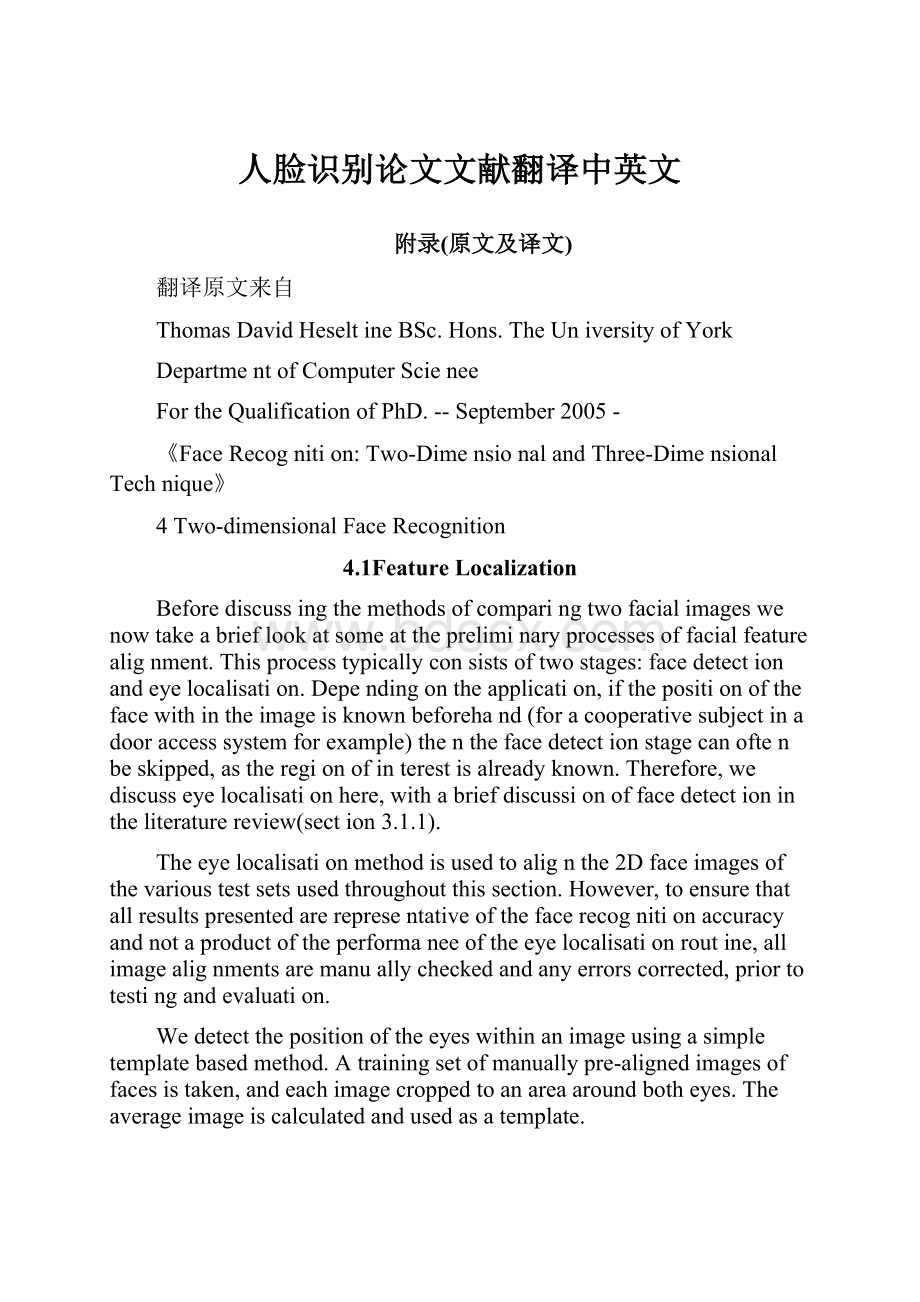人脸识别论文文献翻译中英文.docx
《人脸识别论文文献翻译中英文.docx》由会员分享,可在线阅读,更多相关《人脸识别论文文献翻译中英文.docx(20页珍藏版)》请在冰豆网上搜索。

人脸识别论文文献翻译中英文
附录(原文及译文)
翻译原文来自
ThomasDavidHeseltineBSc.Hons.TheUniversityofYork
DepartmentofComputerScienee
FortheQualificationofPhD.--September2005-
《FaceRecognition:
Two-DimensionalandThree-DimensionalTechnique》
4Two-dimensionalFaceRecognition
4.1FeatureLocalization
Beforediscussingthemethodsofcomparingtwofacialimageswenowtakeabrieflookatsomeatthepreliminaryprocessesoffacialfeaturealignment.Thisprocesstypicallyconsistsoftwostages:
facedetectionandeyelocalisation.Dependingontheapplication,ifthepositionofthefacewithintheimageisknownbeforehand(foracooperativesubjectinadooraccesssystemforexample)thenthefacedetectionstagecanoftenbeskipped,astheregionofinterestisalreadyknown.Therefore,wediscusseyelocalisationhere,withabriefdiscussionoffacedetectionintheliteraturereview(section3.1.1).
Theeyelocalisationmethodisusedtoalignthe2Dfaceimagesofthevarioustestsetsusedthroughoutthissection.However,toensurethatallresultspresentedarerepresentativeofthefacerecognitionaccuracyandnotaproductoftheperformaneeoftheeyelocalisationroutine,allimagealignmentsaremanuallycheckedandanyerrorscorrected,priortotestingandevaluation.
Wedetectthepositionoftheeyeswithinanimageusingasimpletemplatebasedmethod.Atrainingsetofmanuallypre-alignedimagesoffacesistaken,andeachimagecroppedtoanareaaroundbotheyes.Theaverageimageiscalculatedandusedasatemplate.
Figure4-1-Theaverageeyes.Usedasatemplateforeyedetection.
Botheyesareincludedinasingletemplate,ratherthanindividuallysearchingforeacheyeinturn,asthecharacteristicsymmetryoftheeyeseithersideofthenose,providesausefulfeaturethathelpsdistinguishbetweentheeyesandotherfalsepositivesthatmaybepickedupinthebackground.Althoughthismethodishighlysusceptibletoscale(i.e.subjectdistancefromthecamera)andalsointroducestheassumptionthateyesintheimageappearnearhorizontai.Somepreliminaryexperimentationalsorevealsthatitisadvantageoustoincludetheareaofskinjustbeneaththeeyes.Thereasonbeingthatinsomecasestheeyebrowscancloselymatchthetemplate,particularlyifthereareshadowsintheeye-sockets,buttheareaofskinbelowtheeyeshelpstodistinguishtheeyesfromeyebrows(theareajustbelowtheeyebrowscontaineyes,whereastheareabelowtheeyescontainsonlyplainskin).
Awindowispassedoverthetestimagesandtheabsolutedifferencetakentothatoftheaverageeyeimageshownabove.Theareaoftheimagewiththelowestdifferenceistakenastheregionofinterestcontainingtheeyes.Applyingthesameprocedureusingasmallertemplateoftheindividualleftandrighteyesthenrefineseacheyeposition.
Thisbasictemplate-basedmethodofeyelocalisation,althoughprovidingfairlypreciselocalisations,oftenfailstolocatetheeyescompletely.However,weareabletoimproveperformancebyincludingaweightingscheme.
Eyelocalisationisperformedonthesetoftrainingimages,whichisthenseparatedintotwosets:
thoseinwhicheyedetectionwassuccessful;andthoseinwhicheyedetectionfailed.Takingthesetofsuccessfullocalisationswecomputetheaveragedistancefromtheeyetemplate(Figure4-2top).Notethattheimageisquitedark,indicatingthatthedetectedeyescorrelatecloselytotheeyetemplate,aswewouldexpect.However,brightpointsdooccurnearthewhitesoftheeye,suggestingthatthisareaisofteninconsistent,varyinggreatlyfromtheaverageeyetemplate.
Figure4-2-Distancetotheeyetemplateforsuccessfuldetections(top)indicatingvarianceduetonoiseandfaileddetections(bottom)showingcrediblevarianceduetomiss-detectedfeatures.
Inthelowerimage(Figure4-2bottom),wehavetakenthesetoffailedlocalisations(imagesoftheforehead,nose,cheeks,backgroundetc.falselydetectedbythelocalisationroutine)andonceagaincomputedtheaveragedistancefromtheeyetemplate.Thebrightpupilssurroundedbydarkerareasindicatethatafailedmatchisoftenduetothehighcorrelationofthenoseandcheekboneregionsoverwhelmingthepoorlycorrelatedpupils.Wantingtoemphasisethediffereneeofthepupilregionsforthesefailedmatchesandminimisethevarianeeofthewhitesoftheeyesforsuccessfulmatches,wedividethelowerimagevaluesbytheupperimagetoproduceaweightsvectorasshowninFigure4-3.Whenappliedtothediffereneeimagebeforesummingatotalerror,thisweightingschemeprovidesamuchimproveddetectionrate.
Figure4-3-Eyetemplateweightsusedtogivehigherprioritytothosepixelsthatbestrepresenttheeyes.
4.2TheDirectCorrelationApproach
Webeginourinvestigationintofacerecognitionwithperhapsthesimplestapproach,knownasthedirectcorrelationmethod(alsoreferredtoastemplatematchingbyBrunelliandPoggio[29])involvingthedirectcomparisonofpixelintensityvaluestakenfromfacialimages.Weusetheterm‘DirectCorrelation'toencompassalltechniquesinwhichfaceimagesarecompared
directly,withoutanyformofimagespaceanalysis,weightingschemesorfeatureextraction,regardlessofthedstaneemetricused.Therefore,wedonotinferthatPearson'scorrelat
appliedasthesimilarityfunction(althoughsuchanapproachwouldobviouslycomeunderourdefinitionofdirectcorrelation).WetypicallyusetheEuclideandistanceasourmetricintheseinvestigations(inverselyrelatedtoPearson'scorrelationandcanbeconsideredasascale
translationsensitiveformofimagecorrelation),asthispersistswiththecontrastmadebetweenimagespaceandsubspaceapproachesinlatersections.
Firstly,allfacialimagesmustbealignedsuchthattheeyecentresarelocatedattwospecifiedpixelcoordinatesandtheimagecroppedtoremoveanybackgroundinformation.Theseimagesarestoredasgreyscalebitmapsof65by82pixelsandpriortorecognitionconvertedintoavectorof5330elements(eachelementcontainingthecorrespondingpixelintensityvalue).Eachcorrespondingvectorcanbethoughtofasdescribingapointwithina5330dimensionalimagespace.Thissimpleprinciplecaneasilybeextendedtomuchlargerimages:
a256by256pixelimageoccupiesasinglepointin65,536-dimensionalimagespaceandagain,similarimagesoccupyclosepointswithinthatspace.Likewise,similarfacesarelocatedclosetogetherwithintheimagespace,whiledissimilarfacesarespacedfarapart.CalculatingtheEuclideandistaneed,betweentwofacialimagevectors(oftenreferredtoasthequeryimageq,andgalleryimageg),wegetanindicationofsimilarity.Athresholdisthenappliedtomakethefinalverificationdecision.
dqg(dthreshold?
accept)(dthreshold?
reject).Equ.4-1
4.2.1VerificationTests
Theprimaryconcerninanyfacerecognitionsystemisitsabilitytocorrectlyverifya
claimedidentityordetermineaperson'smostlikelyidentityfromasetofpotentialmatchesinadatabase.Inordertoassessagivensystem'sabilitytoperformthesetasks,avarietyof
evaluationmethodologieshavearisen.Someoftheseanalysismethodssimulateaspecificmodeofoperation(i.e.securesiteaccessorsurveillanee),whileothersprovideamoremathematicaldescriptionofdatadistributioninsomeclassificationspace.Inaddition,theresultsgeneratedfromeachanalysismethodmaybepresentedinavarietyofformats.Throughouttheexperimentationsinthisthesis,weprimarilyusetheverificationtestasourmethodofanalysisandcomparison,althoughwealsouseFisherLinearDiscriminanttoanalyseindividualsubspacecomponentsinsection7andtheidentificationtestforthefinalevaluationsdescribedinsection8.Theverificationtestmeasuresasystem'sabilitytocorrectlyacceptorrejecttheproposedidentityofanindividual.Atafunctionallevel,thisreducestotwoimagesbeingpresentedforcomparison,forwhichthesystemmustreturneitheranacceptanee(thetwoimagesareofthesameperson)orrejection(thetwoimagesareofdifferentpeople).Thetestisdesignedtosimulatetheapplicationareaofsecuresiteaccess.Inthisscenario,asubjectwillpresentsomeformofidentificationatapointofentry,perhapsasaswipecard,proximitychiporPINnumber.Thisnumberisthenusedtoretrieveastoredimagefromadatabaseofknownsubjects(oftenreferredtoasthetargetorgalleryimage)andcomparedwithaliveimagecapturedatthepointofentry(thequeryimage).Accessisthengranteddependingontheacceptance/rejectiondecision.
Theresultsofthetestarecalculatedaccordingtohowmanytimestheaccept/rejectdecisionismadecorrectly.Inordertoexecutethistestwemustfirstdefineourtestsetoffaceimages.Althoughthenumberofimagesinthetestsetdoesnotaffecttheresultsproduced(astheerrorratesarespecifiedaspercentagesofimagecomparisons),itisimportanttoensurethatthetestsetissufficientlylargesuchthatstatisticalanomaliesbecomeinsignificant(forexample,acoupleofbadlyalignedimagesmatchingwell).Also,thetypeofimages(highvariationinlighting,partialocclusionsetc.)willsignificantlyaltertheresultsofthetest.Therefore,inordertocomparemultiplefacerecognitionsystems,theymustbeappliedtothesametestset.
However,itshouldalsobenotedthatiftheresultsaretoberepresentativeofsystemperformanceinarealworldsituation,thenthetestd